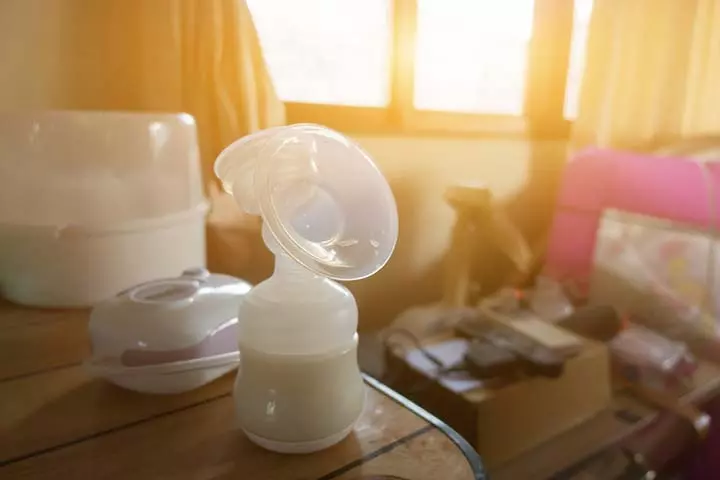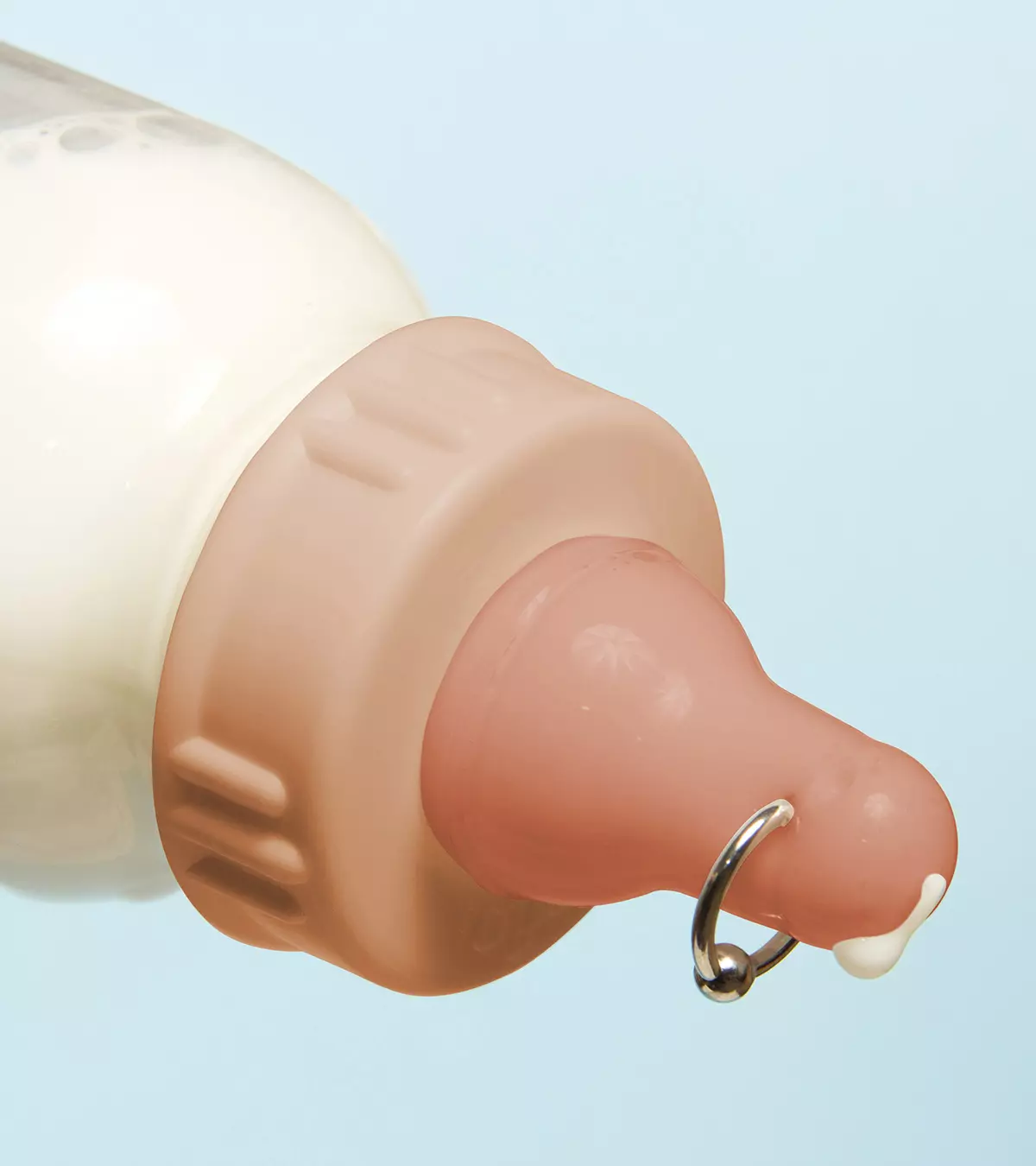
Image: Shutterstock
Fat is an important macronutrient in an infant’s diet. Aside from being the major energy source in breast milk, fats, and their metabolites aid in a baby’s brain development and growth. The amount of fat in human breast milk varies throughout the day (1).

This alternation of breast milk fat levels is common and nothing to be worried about. However, there are ways to determine if your baby is receiving adequate fat from the breast. In this post, we have written about the same and how to increase fat in breast milk.
Key Pointers
- The type and quantity of fat present in breast milk depends on the mother’s diet and nutritional status.
- Consuming healthy, fat-rich foods by the mother is important to facilitate the good health for the baby.
- Certain simple tips such as breast massaging, emptying one breast at a time, and maintaining a nutritious diet can help increase healthy fats in breast milk.
What Is The Average Fat And Calorie Content In Breast Milk?

Human breast milk composition undergoes subtle changes with each feed to meet the infant’s developmental needs. However, on average, the calorie and fat content ranges are as follows (2).
Nutrient | Average |
Energy | 70kcal/dL |
Fat | 3.6g/dL |
kcal = kilocalories, dL = deciliter (1dL = 100ml)Source: Australian Breastfeeding Association
What Are The Different Types Of Fat Present In Breast Milk?

The type of fat present in breast milk is dependent on the maternal diet. These fats may include (3) (4) (5):
- Triacylglycerols
- Polyunsaturated fatty acids, including omega-3 fatty acid (docosahexaenoic (DHA) and arachidonic (ARA)) acids, and omega-6 fatty acid (linoleic and arachidonic acids)
- Cholesterol
- Monounsaturated fatty acids
What Are The Factors That Influence Fat In Breast Milk?

The following factors affect the fat composition in breast milk.
1. Emptiness of the breast: The amount of fat usually fluctuates based on the emptiness of the breast. The emptier the breast, the higher is the fat content. Moreover, hindmilk (the milk that comes towards the end) is richer in fat than foremilk (first-released milk) (3) (6).
2. Time of the feed: Breast milk supply in the evenings and nights usually has more fat content. It occurs due to the gradual accumulation of fat in the milk throughout the day. Babies may feed less frequently during the day since they nap, providing them with milk with more fat content in the evening and night (7) (8).
3. Nutritional status of the mother: The types and amount of fat a lactating mother consumes is passed on to the infant through the milk. Therefore, it is essential that nursing mothers consume foods with a healthy fatty acid composition.
What Are The Ways To Increase Fat And Nutrients In Breast Milk?

The following steps may help you increase the fat and nutrient content of breast milk.
1. Empty an entire breast
Ensure that your baby finishes the milk from one breast before switching to the other side. The baby will get the watery foremilk and fat-rich hindmilk. If you switch to the other side, your breasts may fill with foremilk again, reducing its overall fat content. In case you need to switch during feeding, use a breast pump to store the hindmilk and feed the baby later. Flipping the baby between breasts before complete emptying may also lead to breast engorgement and resulting fast milk letdown.
 Quick tip
Quick tip2. Massage the breasts
You may consider a lactation massage. Gentle breast compression before and during feed may help move the fattier milk forward and clear the milk ducts (9). It may also help empty the breast better and improve the milk’s fat content.
3. Consume a balanced diet
A healthy maternal fat intake could help ensure that breast milk has healthy fat content and quality. The adequate monounsaturated and polyunsaturated fatty acid content in breast milk could help in the baby’s brain development. In addition, the consumption of lean meat, egg, flaxseed, vegetable oils, sunflower seeds, flax seeds, soybean, and fatty fish could improve the nutritional quality of human breast milk (10). You can also ask your doctor to provide you with a list of food for breastfeeding mothers.
 Did you know?
Did you know?Why Is Breast Milk Important For Your Baby?

Breast milk provides the required amounts of nutrients that an infant needs for healthy weight gain and development. It is the best food for babies since it is easy to digest and customized as per their nutritional needs.
Breast milk is slightly thick and nutrient-dense during the initial three to four days after birth. In addition, this type of milk, called the colostrum, is rich in immunological components such as lactoferrin, antibodies, and leukocytes that help reduce the risk of several common childhood illnesses in breastfed infants (3) (11). Breast milk also has several psychological benefits as it helps the mothers and infants bond. The hormone oxytocin released during breastfeeding naturally calms the nursing mother and the infant (12).
Frequently Asked Questions
1. Does sunflower lecithin increase fat in breast milk?
Yes, lecithin supplements increase the amount of polyunsaturated fatty acids in breast milk. Therefore, some mothers take it to prevent milk ducts from blocking (13).
2. Does the fat in my milk affect my baby’s growth?
The fat in your milk plays an important role in optimal infant nutrition as fat is essential for babies’ brain development, absorption of vitamins, and energy. Long-chain fatty acids are helpful for the development of the brain, retina, and nervous system (14).
3. How can I increase the fat content of breast milk if I have low milk supply?
Frequent breastfeeding or pumping, ideally every 2-3 hours during the day and at least once or twice during the night, eating a well-balanced diet, staying optimally hydrated, and encouraging longer breastfeeding sessions can help increase both milk supply and the fat content of breast milk, providing optimal nutrition to the baby (7) (10) (17).
4. Which fruits help increase breast milk?
Apricots and dates can increase prolactin levels, which may help increase breast milk production. However, consuming these fruits alone won’t be beneficial. Instead, consuming a well-balanced diet that includes foods that increase breast milk and nutritious options from different food groups can help you maintain healthy breast milk production and supply (18).
5. Does maternal stress influence fat in breast milk?
Although there is limited research on the effect of maternal stress on fat content in human breast milk, a few animal studies suggest that environmental stress and social factors may lead to a reduction in the nutritional and fat content of milk (19).
Altering fat content in human milk is nothing to be concerned about. Instead, observe your breast milk pattern and your baby’s fullness to grasp an idea of whether your baby is well-fed or not. By adopting effective home care measures and feeding practices, mothers can improve the nutritional value of breast milk. Additionally, keeping a journal of the infant’s feeding patterns and breast emptiness and visiting a lactation consultant could help you better understand your breast milk’s fat content.
Infographic: Importance Of Fats For Babies
Now that you know how to ensure your baby gets all the fat from your breast milk, you may want to know why fat is so important for babies? This infographic presents the various reasons why fat is vital for the healthy growth and development of the baby.
Some thing wrong with infographic shortcode. please verify shortcode syntax
Some thing wrong with illustration image shortcode. please verify shortcode syntax
Learn how to make your breast milk more fattening with simple tips and tricks! Get the best advice to ensure your baby is getting the nutrition they need.
References
- S.C. Hardy and R.E., Kleinman Fat And Cholesterol In The Diet Of Infants And Young Children: Implications For Growth, Development, And Long-Term Health.
https://pubmed.ncbi.nlm.nih.gov/7965456/ - Breastmilk Composition.
https://www.breast feeding .asn.au/bfinfo/breastmilk-composition - Olivia Ballard and Ardythe L. Morrow, Human Milk Composition: Nutrients and Bioactive Factors.
https://www.ncbi.nlm.nih.gov/pmc/articles/PMC3586783/ - R. Jenness, The Composition Of Human Milk.
https://pubmed.ncbi.nlm.nih.gov/392766/ - Koletzko. B, Human Milk Lipids.
https://www.karger.com/Article/Fulltext/452819 - S. E. Daly et al., Degree Of Breast Emptying Explains Changes In The Fat Content, But Not Fatty Acid Composition, Of Human Milk.
https://pubmed.ncbi.nlm.nih.gov/8311942/ - Breastfeeding at Night.
https://www.laleche.org.uk/breastfeeding-at-night/ - Worries About Foremilk And Hindmilk.
https://breast feeding usa.org/content/article/worries-about-foremilk-and-hind milk - Breast Massage.
https://www.uhhospitals.org/services/obgyn-womens-health/patient-resources/pregnancy-resources/Breastfeeding-Guide/breastfeeding-tips-to-increase-your-milk-supply - Sandra L. Huffman et al., Essential Fats: How Do They Affect Growth And Development Of Infants And Young Children In Developing Countries? A Literature Review.
https://www.ncbi.nlm.nih.gov/pmc/articles/PMC6860654/ - The Importance Of Breastfeeding.
https://www.ncbi.nlm.nih.gov/books/NBK52687/ - Kathleen M. Krol and Tobias Grossmann, Psychological Effects Of breast feeding On Infants And Mothers.
https://www.ncbi.nlm.nih.gov/pmc/articles/PMC6096620/ - Lecithin
https://www.canadianbreastfeedingfoundation.org/basics/lecithin.shtml - What’s In Breast Milk?
https://americanpregnancy.org/healthy-pregnancy/first-year-of-life/whats-in-breastmilk/ - Foremilk and Hindmilk.
https://llli.org/breastfeeding-info/foremilk-and-hindmilk/ - Try Maya Syafputri et al.; (2015); Effect of Virgin Coconut Oil on Prolactin Levels and Breast Milk Production in Postpartum Mothers.
https://ijshr.com/IJSHR_Vol.7_Issue.2_April2022/IJSHR045.pdf - Increasing your breast milk supply
https://www.childrens.health.qld.gov.au/health-a-to-z/breastfeeding/increasing-breast-milk-supply - Top 10 superfoods for breastfeeding moms
https://news.sanfordhealth.org/womens/top-10-breastfeeding-superfoods/ - A. Razzaghi et al. (2025); The impact of environmental and nutritional stresses on milk fat synthesis in dairy cows
https://www.sciencedirect.com/science/article/abs/pii/S0739724022000753
Community Experiences
Join the conversation and become a part of our nurturing community! Share your stories, experiences, and insights to connect with fellow parents.
Read full bio of Dr. Jessica Madden
- Sarah Whipkey is a registered dietitian nutritionist in Houston, Texas area. She specializes in plant-based nutrition and shares her knowledge and passion of whole plant foods with clients through her private practice, The Plant Potential. She did her BS in Nutrition and Dietetics from Texas State University.
 Sarah Whipkey is a registered dietitian nutritionist in Houston, Texas area. She specializes in plant-based nutrition and shares her knowledge and passion of whole plant foods with clients through her private practice, The Plant Potential. She did her BS in Nutrition and Dietetics from Texas State University.
Sarah Whipkey is a registered dietitian nutritionist in Houston, Texas area. She specializes in plant-based nutrition and shares her knowledge and passion of whole plant foods with clients through her private practice, The Plant Potential. She did her BS in Nutrition and Dietetics from Texas State University.
Read full bio of Sindusha MS
Read full bio of Rohit Garoo
Read full bio of Anindita Ghatak


















